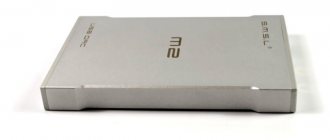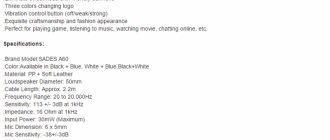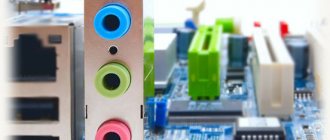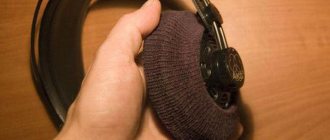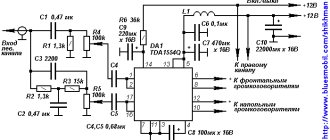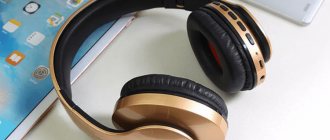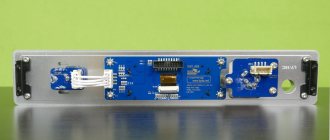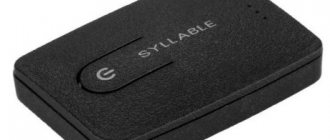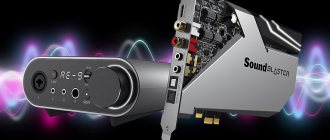Choosing a USB DAC for a smartphone and PC. 7 available options for replacing the built-in sound card
Everyone knows that the quality of the vast majority of sound cards built into a smartphone or computer leaves much to be desired. And I really want the best. Almost the entire HiFi and HiEnd audio industry is working in this direction today. But here’s the price tag... Those who have already mastered the world of good sound are quite capable of paying up to a hundred dollars for a mobile DAC. What should those who just want to take their first timid steps do? It is this question that I propose to address by considering 7 of the most interesting cheap solutions.
Dac Audio TDA1305
Sold here
The first option was already reviewed by me once. It is based on a chip from Philips: TDA1305. USB connection, maximum available quality - 16 bit 48 kHz. A basic replacement for the built-in sound card, it sounds fun and musical, but doesn’t offer much in the way of characteristics.
WM8740 USB OTG
Sold here
The next option at a similar price is much more interesting. After all, he uses the famous Wolfson WM8740 with a MAX97220 amplifier as a converter. The maximum quality is also not great - up to 16 bits 48 kHz, but the device is capable of delivering more than 100 mW of power to the headphones into a 32 ohm load. Which, besides the price, is the main advantage of the device.
Dac Audio ES9023
Sold here
Another good option is already on the ESS ES9023 chip. I myself am a big fan of the chips from this company, they sound very bold and detailed. The maximum quality and output level are completely similar to the previous ones. Here the gain comes from a more modern DAC. The connection is made via USB Type A.
USB CYBERDRIVE
Sold here Buy here
Finally, the option that I myself am drooling over is USB CYBERDRIVE. Inside there is a full-fledged XMOS USB chip, an external frequency generator and a full-fledged DAC with DSD CS4398 support. The maximum quality is simply fabulous for its price category. DSD256 and PCM up to 192 kHz/24 bit are declared. The output power is more than 40 mW into a 32 ohm load. What is called “must be taken.” In terms of hardware, the device is incredibly cool.
CS4398
Sold here
A slightly simpler option using a USB chip, but with a built-in TDA1308 headphone amplifier. The same CS4398 works as a DAC. XMOS is not already installed here, which means DSD support is unlikely. However, it is still a very interesting device, and ASIO drivers can be found online upon request: CM108.
ALC5686
Sold here
A very inexpensive solution based on Realtek ALC5686. Don’t be fooled, whistles with this chip cost approximately the same, there are no revelations here in this sense. However, the chip itself is one of the best from Realtek with normal gain and quality up to 32 bit 384 kHz. and support for Type C connection. Through an adapter it can also be used with a computer. There is support for headsets with a microphone and control buttons.
GGMM
Sold here
Well, the last element will be a mobile DAC with Type With GGMM connection. We are promised maximum quality up to 24 bits 192 kHz. The page contains drivers for your computer and, what’s nice, built-in music control buttons. The DAC in this device is the already proven Wolfson WM8533, and the amplifier is the MAX97220. The pairing should have about 100 mW of power per headphones, which is quite good. Well, the appearance of the device, so to speak, is favorable.
The main thing you need to understand when purchasing this type of device is that the DAC only works for playback and often you won’t be able to slip a microphone into it. There are, of course, exceptions. For example, devices based on ALC5686 are quite capable of working with a headset, since a codec is installed inside. CODEC from the words encoder and decoder, that is, in two directions. But the DAC is only from digital to analogue - there is no other way.
Of all the above, the most tasty morsel for me is USB CYBERDRIVE. A very solid filling for some frivolous money. Everything else is less interesting, but deserves additional explanation. So Wolfson DACs have always given a very massive, soft and solid sound. This is why they are still loved today. Cirrus Logic is often completely neutral, and ESS is somewhere in the middle. Codecs are capable of supporting headsets, that is, they can also work with a microphone and music control buttons.
Packaging and equipment.
The manufacturer didn’t invent or invent anything; the D2 comes in a small white cardboard box. The cardboard is thick, and from the information - all the most important, minimalism in general.
On the side there is a hint that it was developed in China, there is a link to class=”aligncenter” width=”800″ height=”600″[/img] Again there are no recesses for fingers, but the box opens under the weight of the device, you just need to shake it a little .
The device is located on a foam substrate, in which a cutout is made for a recess.
I didn’t find any documentation in the kit at all, there are only 2 cables, Micro USB-USB, and a short micro usb - micro usb, for connecting to a smartphone, for example.
Simple audio DAC with USB connection (sound card)
As it turns out, making an external USB sound card is easy and inexpensive. In this article I will tell you how I did it.
Background:
A couple of years ago, on the Internet, on one of the forums, a topic about audio DACs caught my eye. I was very excited about the idea of soldering an audio card(!) and began reading descriptions of various designs with great interest. I was repelled by their repetition by complex (I had no idea where I would get the “square bus” I2C on a computer from or where to get S/PDIF) circuits and expensive (this was the most compelling argument) components. There is still very little material on this topic in Russian... A couple of months later I found a simple design on a PCM2702 chip and, most importantly, with a connection to a computer via USB. I was not afraid of the SSOP chip package, but I was afraid of the price - more than 500 rubles apiece. I was also afraid of ruining such an expensive microcircuit with my inexperience (overheating, static... you never know?). I began to look for other solutions. And I came across a design based on PCM2705. This is also a USB codec, but with lower characteristics compared to the PCM2702. I found the microcircuit in a crowd on one of the forums. I ordered one for myself and a friend. I don’t remember exactly at what price, but no more than 150 rubles per piece.
Scheme:
The scheme was repeated almost identically to the original source. And he has an almost clean datasheet there.
Pay:
I made my own version of the printed circuit board. I had already mastered LUT then.
First start:
I soldered it (I thought I couldn’t solder it with a five-millimeter tip, but thanks to DI-HALT for the idea with the microwave).
With trembling hands I connected it to the computer... The OS detected a new device. Installed the drivers. I plugged in my headphones and started singing! And, moreover, no worse than the sound system built into the laptop. And even better! At least I heard a difference in the low frequencies. I didn't notice it on HF. But my headphones are not of the best quality. I also soldered it to my friend, connected it and... it doesn’t work. I changed the capacitors in the quartz harness - it didn’t help, I changed the quartz itself - it worked!
Do you use it?
I use it. Sometimes I turn it on when I want better sound. I would turn it on more often, but it’s inconvenient to use it - I haven’t made the case yet, I carry the laptop back and forth...
Modernization:
If you use an external power supply with low-noise stabilizers, the sound will become better, because USB bus power contains a lot of different noise. You can also experiment with resistors R7, R8 - set them smaller and increase capacitors C12, C13 - the transmission of low frequencies will improve. It was also possible to output S/PDIF, but I had nowhere to attach a track on the printed circuit board, and I didn’t need it then. And so, it is located on the 5th pin of the microcircuit. A double-sided, well-designed PCB would not be detrimental to this design. Since a whole layer of copper will be allocated to the ground, this will shorten the return current paths and reduce the level of interference. At the moment, if there is a mobile phone next to this DAC and receives an incoming call or message, then the familiar “you-you-you-you... you-you-you-you... you-s-s-s-s” can be clearly heard in the headphones. s...”
I can't find PCM2705...
Analogues of PCM2705 are the PCM2704-2707 line.
Briefly about them: PCM2704: 28-Pin SSOP, Headphone and S/PDIF Output, External ROM Interface PCM2705: 28-Pin SSOP, Headphone and S/PDIF Output, Serial Programming Interface PCM2706: 32-Pin TQFP, Headphone and S/PDIF Output, I2S Interface, External ROM Interface PCM2707: 32-Pin TQFP, Headphone and S/PDIF Output, I2S Interface, Serial Programming Interface You can use any of them, they are the same in quality. I attach the datasheet in the archive along with the diagram and board (open in Sprint Layout 5).
How to choose the right DAC headphone amplifier
When choosing a DAC, the following criteria are taken into account:
- Inputs . Their number determines which devices will be used as a sound source. The converter connects to a computer and smartphone via USB. Coaxial and optical standards are also used. And advanced models support Wi-Fi and Bluetooth.
- Exits. Their set depends on the specific use of the DAC. To use headphones you will need a 3.5mm jack. If you plan to connect the converter also to audio equipment, you need linear and coaxial outputs.
- Sampling and bit depth. These parameters determine the quality of the reproduced sound. For example, for the CD format the bit depth is 16 bits, while for Hi-Res it is from 24. The sampling rate for CD is 44.1 kHz, and for Hi-Res it exceeds 94 kHz.
What is Hi-Res Audio
- Dimensions. The dimensions of the product determine its purpose. Compact models are now popular; they fit easily in a pocket and are often used with a smartphone or tablet.
- Price. The price of the device depends not only on the user’s budget, but also on what equipment the amplifier will work with. For example, a portable model is suitable for listening to music from a player or smartphone.
Rating of the best DACs for listening to music
